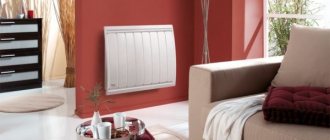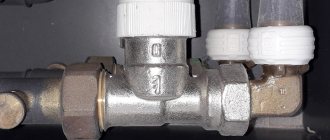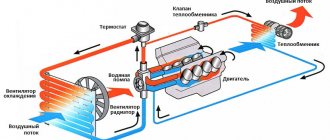The central heating system does not always provide high-quality heating of the home. Under such circumstances, additional heating units are used to create a comfortable microclimate in the rooms. Radiators and convectors are often used for such purposes. They come in different types and differ in their operating principles. To understand which heating equipment is more profitable to use in a particular situation, you need to understand the characteristics, advantages and disadvantages of popular devices.
When choosing between a radiator and a convector for heating a home, you need to evaluate the characteristics and advantages of each of them Source i.ytimg.com
Oil radiators
Heating devices radiate heat in different directions, creating a flow of warm air that is directed upward. As a result of this process, rapid heating of the room occurs.
Most often, oil radiators are used as additional heating units. The main way they differ from convector equipment is their large working area. Due to the circulation of hot mineral oil through the circuit, the entire surface of the radiator is heated. Such devices can be placed anywhere in the room (along the walls, under the table). There are also models designed for wall use only.
There is a heating element inside the oil cooler that warms up the oil, then it releases heat to the surrounding area Source gopb.ru
Pros:
- relatively fast heating of the room;
- mobility of the device;
- presence of built-in thermostats;
- simple maintenance;
- affordable price.
Minuses:
- there is a danger of getting burned due to the strong heating of the device, especially if there are small children in the house;
- Leaks may form in low-quality units;
- are used to produce only additional heat.
The oil radiator should not be left unattended - it is not intended for constant operation Source tehno-rating.ru
Safety first
The types of devices being compared are classified as high-risk heating devices. The devices are equipped with built-in overheating protection. When the maximum temperature is reached, the device automatically turns off.
Electrical devices have an increased risk of electric shock. To prevent injury, it is necessary to strictly comply with fire and electrical safety requirements.
Some models are used in rooms with high humidity. To protect against damage, the devices have a high degree of sealing.
Radiators for water heating
They are used in permanent heating systems (centralized, autonomous). The heating process occurs with the help of a coolant circulating through the circuit. Unlike oil radiators, water radiators do not require power. Connecting a heating system with the latter to a gas boiler significantly reduces the cost of heating a home.
If thermostatic valves are installed on water radiators, it will be possible to set the required temperature in each individual room.
When choosing radiators for water heating, it is extremely important to pay attention to the material they are made from Source kermi.su
Pros:
- huge heat transfer;
- environmental friendliness;
- relatively high power.
Minuses:
- considerable cost;
- excessive heating of the case.
If water radiators are connected to a single heating system, then the temperature in all rooms of the house will be the same Source roomester.ru
Additional functions
Convectors:
- Electronic control, display, remote control. These “bells and whistles” allow you to more accurately set the required temperature and control the device without leaving the couch. Radiators with a mechanical thermostat cannot boast of such accuracy.
- Operating modes. Most convectors are equipped with preset modes that allow, for example, saving energy (“economy” mode).
Oil radiators:
- Drying things. Additional slats where you can hang and dry things are the strongest advantage of the radiator. This trick will not work with convectors.
General features:
- Built-in ionizer. There is still debate about the benefits of air ionization, however, many models have this option.
- Frost protection. A function that allows you to maintain a low positive temperature in the room for a long time if the owners are absent for a long time.
- Humidifier. A useful option especially for dry climates. Moreover, the humidifier works autonomously and can always be turned off if the room is very damp.
- Timer. Allows you to preset the time by which the device will warm up the room.
The difference between a convector and a radiator
The difference between a convector and a radiator
Having examined the principles of operation, design features, pros and cons of various devices, you can begin to compare them. It is also worth noting that modern heating units are constantly being improved; new models no longer have significant shortcomings.
The main differences between a convector and a radiator are:
- Compactness. Convector units are more compact and require less space for installation.
- Housing heating rate. Convectors cope with this task faster. But after switching off, they immediately stop heating the room, and the radiators continue to give off heat for some time.
- Safety. The convector body heats up less than the radiator. If you touch the hot surface of the latter, you can get burned.
- Heating of large areas. The radiator copes with this task much more efficiently.
- Easy to maintain. To properly clean a convector unit, it is important to understand how dust gets into it. To clean the radiator, you only need to wash the housing or remove dirt from it.
- Price. It is impossible to unequivocally answer the question which unit (radiator or convector) is more expensive. Due to the significant number of models, there are deviations in different directions.
Device Operation
The difference in operation is also quite significant for devices such as a convector and a radiator. It will be useful to know the advantages and disadvantages before purchasing. In terms of energy costs, a convector is undoubtedly more profitable. It consumes 25% less energy than a radiator. This is due to the difference in the rate of heating of the air.
During operation, the convector also benefits in terms of mobility. It is lighter than the radiator, so moving the device will be easier. The ability to install the convector on the wall allows you to avoid cluttering the space. This factor simplifies cleaning in the apartment. An oil heater weighs from 18 to 25 kg, so moving it (especially when hot) is quite difficult. Even with wheels, this process is problematic.
What to choose: radiator or convector?
The choice of a heating device largely depends on the conditions of its use, the characteristics of the room, and financial capabilities. Numerous reviews about the use of different radiators and convectors indicate that the latter option is more profitable to buy. Among its positive aspects, they often note: efficiency, significant heat transfer, elegant design, and the ability to heat large rooms. But in order to make a final conclusion, it is worth carefully considering all the pros and cons of individual units.
Typically, convectors are more expensive than radiators. That's why many people prefer the latter. In fact, this is not always beneficial. Convector units have a number of undeniable advantages; their purchase is optimal for most cases.
Technical characteristics and cost of heaters
The main characteristics and cost of heating radiators and convectors are given in the table.
| Model name | Specifications | Manufacturer country | Cost, rub. |
| Radiators | |||
| Ballu BOH/CL-05WRN 1000 | Number of modes – 3. Number of sections – 5. Power, kW – 1.0. Heating area, m2 – 15. Control – mechanical. Thermostat - yes. Weight, kg – 4.2. | Russia | 1 990 |
| Vitek VT-1709 W | Number of modes – 3. Number of sections – 9. Power, kW – 2.0. Heating area, m2 – 20. Control – mechanical. Thermostat - yes. Weight, kg – 6.5. Functions: * shutdown when overturning; * overheat protection. | China | 3 990 |
| De Longhi TRRS0920C | Number of modes – 3. Number of sections – 9. Power, kW – 2.0. Heating area, m2 – up to 24. Control – mechanical. Thermostat - yes. Weight, kg – 12. Functions: * frost protection. | China | 8 990 |
| Convectors | |||
| Ballu BEC/EM-1000 | Number of modes – 2. Power, kW – 1.0. Heating area, m2 – up to 15. Control – mechanical. Thermostat - yes. Weight, kg – 3.0. Functions: * shutdown when overturning; * overheat protection. | Russia | 1 990 |
| Electrolux ECH/B-1500 E | Number of modes – 5. Power, kW – 1.5. Heating area, m2 – up to 20. Control – electronic. Thermostat - yes. Weight, kg – 3.0. Functions: * shutdown when overheating; * frost protection. | China | 5 790 |
| Bork R704 | Number of modes – 3. Power, kW – 1.0. Heating area, m2 – up to 20. Control – electronic. Thermostat - yes. Weight, kg – 5.6. Functions: * touch screen; * automatic maintaining heat; * shutdown when overturning; * protection from children; * overheat protection; * remote control. | China | 12 890 |
Comparison of tabular data shows a slight increase in the cost of convectors. This is due to the increasing degree of automation and the presence of a large number of useful functions.
The final assessment of whether convectors or heating radiators is better will be made by comparing the operating and maintenance features of the devices.
Center distance
| Parameter | Radiator Rifar Monolit | Convector TS CARNOT |
| Center distance | 80 mm - non-standard | 50 mm - standard |
Rifar radiators have come up with their own standard, which only fits their connection nodes. Convectors use standard components, similar for all manufacturers.
Rifar Radiator Assemblies
Standard components of the TS CARNOT convector
Durability
The convector and radiator have different service life. The differences in this indicator are significant. Of course, a lot depends on the manufacturer and build quality of the device. Taking into account the general principle of operation of such equipment, experts advise purchasing convectors. Their service life reaches a record 15 years.
Oil radiators cannot boast of such indicators. The substance inside the sections corrodes their material. Therefore, such devices rarely operate for more than 7 years. And most models are not used even longer than five. First, a microcrack appears in the housing. It is not visible to the naked eye. Over time, it increases and oil begins to leak out. Such heaters cannot be repaired. Therefore, it is better to give preference to convector devices.
Paint colors
| Parameter | Radiator Rifar Monolit | Convector TS CARNOT |
| Paint color | Only white | Any according to RAL |
Radiators come from the factory exclusively in the standard white color.
Convectors can be painted in any color without increasing the cost, thereby solving the problems of interior design of the room. The color can be selected from more than 220 different shades.
Various color options for TS CARNOT convectors
In both cases, safe to use and durable powder coating is used.
Component life and manufacturer's warranty
| Parameter | Radiator Rifar Monolit | Convector TS CARNOT |
| Life time | 25 years | 50 years |
| Manufacturer's Warranty | 25 years | 10 years |
The service life of convectors is 2 times longer. This is achieved due to the almost eternal materials from which the heat exchanger is made: copper tube and aluminum fins. However, the warranty obligations stated in the passport of convectors are lower.
Radiators use less durable steel tubes. It should also be remembered that the warranty is valid only if all installation and operating conditions are fully observed.
Rifar radiator internals
Let's turn to the Rifar Monolit passport.
The very first points of the guarantee in practice turn out to be impossible for a simple buyer who bought a radiator in the nearest market and used the services of a private plumber. In this case, there is neither a project nor licenses, and besides, design costs serious money. After 15 years, in the event of a breakdown, it will be impossible to prove that this breakdown is a warranty case, so it turns out to be easier to buy a new radiator.
To obtain a warranty for a convector, no special conditions are required. If any of its parts fail, an engineer will come and replace them on site.
From practice : in 3 years of working with convectors there were no warranty claims. The specialist was called several times, allegedly with warranty cases, but right at the site it became clear that the damage to the tube was mechanical in nature due to negligence during the repair process. Engineers on site corrected the problem by replacing the heat exchangers.











